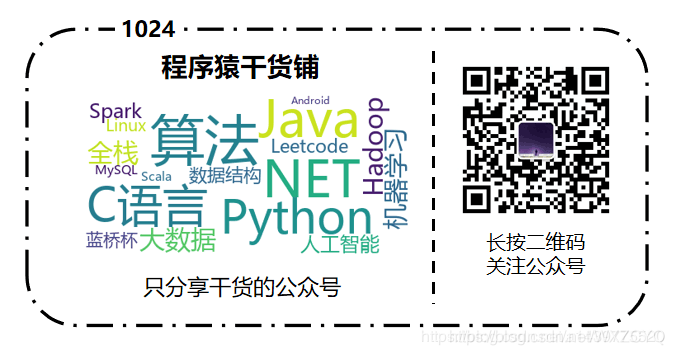一群热爱技术并且向往优秀的程序猿同学,不喜欢水文,不喜欢贩卖焦虑,只喜欢谈技术,分享的都是技术干货。Talk is cheap. Show me the code

Spring Boot 20天入门(day8)
Springboot 缓存
缓存使用
首先我们需要引入相关依赖:
<dependency>
<groupId>org.springframework.boot</groupId>
<artifactId>spring-boot-starter-cache</artifactId>
</dependency>
然后在Springboot的配置类上(一般是启动类)标注@EnableCaching注解开启缓存
@EnableCaching
@MapperScan(value = "com.github.springbootcache.mapper",basePackageClasses = Repository.class)
@SpringBootApplication
public class SpringBootCacheApplication {
public static void main(String[] args) {
SpringApplication.run(SpringBootCacheApplication.class, args);
}
}
最后在需要使用缓存的方法上添加下列注解:
@Cacheable //将方法的运行结果进行缓存;第二次再要相同的数据,直接从缓存中获取,不再调用方法;
@CacheEvict //移除缓存
@CachePut //修改了数据库的某个数据,同时更新缓存
1、Cacheable:
value/cacheNames :表明缓存存放在哪个命名空间下
key : 缓存数据时的key,默认使用方法参数的值,编写 SPEL表达式 : #id,参数id的值 #a0 #p0 #rrot.args[0]
keyGenerator : key生成器,可以自己指定的组件id
key/keyGenerator 二选一
cacheManager : 指定缓存管理器
condition : 指定符合条件的情况下缓存,condition = "#id>0"
unless : 否定缓存,当unless为true,方法的返回值不会缓存,可以获取到结果进行判断,unless = "#result==null"
sync : 是否使用异步模式
2、@CacheEvit:
@CacheEvit:缓存清除
@CacheEvit和@Cacheable的相同属性就不再赘述。
1、allEntries = true 每次删除,将指定缓存中的所有数据全都删除
2、beforeInvocation=false ,缓存的清除是否是在方法之前执行,默认false, 即在方法之后清除,当方法执
行出现异常时,缓存不会清除。
beforeInvocation=true ,方法之前清除,无论方法执行是否出现异常,缓存都会清除
3、@CachePut:
先调用目标方法,然后讲方法的返回值存进缓存中,属性和@Cacheable一致
4、@CacheConfig:
标注在类上,指定全局的属性,简化代码
@Target({ElementType.TYPE})
@Retention(RetentionPolicy.RUNTIME)
@Documented
public @interface CacheConfig {
String[] cacheNames() default {};
String keyGenerator() default "";
String cacheManager() default "";
String cacheResolver() default "";
}
5、@Caching:
将@Cacheable、@CachePut、@CacheEvit组合使用,可以写出复杂的注解逻辑
@Target({ElementType.TYPE, ElementType.METHOD})
@Retention(RetentionPolicy.RUNTIME)
@Inherited
@Documented
public @interface Caching {
Cacheable[] cacheable() default {};
CachePut[] put() default {};
CacheEvict[] evict() default {};
}
缓存实战
实体类:
import java.io.Serializable;
/**
* @Description : TODO
* @Author : Weleness
* @Date : 2020/05/22
*/
public class User implements Serializable {
private static final long serialVersionUID = 3564291823518067604L;
private Integer id;
private String username;
private String password;
public User(Integer id, String username, String password) {
this.id = id;
this.username = username;
this.password = password;
}
public User() {
}
public static long getSerialVersionUID() {
return serialVersionUID;
}
public Integer getId() {
return id;
}
public void setId(Integer id) {
this.id = id;
}
public String getUsername() {
return username;
}
public void setUsername(String username) {
this.username = username;
}
public String getPassword() {
return password;
}
public void setPassword(String password) {
this.password = password;
}
@Override
public String toString() {
return "User{" +
"id=" + id +
", username='" + username + '\'' +
", password='" + password + '\'' +
'}';
}
}
User服务:
@Service
public class UserSevice {
@Autowired
private UserMapper userMapper;
@Cacheable(cacheNames = "user")
public User getUser(Integer id){
System.out.println("id");
return userMapper.getUserById(id);
}
}
controller:
**
* @Description : TODO
* @Author : Weleness
* @Date : 2020/05/22
*/
@RestController
public class UserController {
@Autowired
private UserSevice userSevice;
@GetMapping("/user/{id}")
public User getUser(@PathVariable("id")Integer id){
return userSevice.getUser(id);
}
}
启动项目,访问接口:
可以看到,第一次访问的时候,执行了sql语句进行查询了。

清空控制台,再次访问:

可以看到控制台没有打印任何日志信息,但是网页获取到了数据,缓存开启成功。
缓存原理
了解过Springboot自动配置原理的同学都清楚,Springboot有各式各样的的xxxAutoConfiguration来帮我们自动配置和引入一些必要的组件。
CacheConfiguration
@Configuration(proxyBeanMethods = false)
@ConditionalOnClass(CacheManager.class)
@ConditionalOnBean(CacheAspectSupport.class)
@ConditionalOnMissingBean(value = CacheManager.class, name = "cacheResolver")//当我们没有自己配置缓存管理器时
@EnableConfigurationProperties(CacheProperties.class)//从配置文件中获取配置
@AutoConfigureAfter({ CouchbaseAutoConfiguration.class, HazelcastAutoConfiguration.class,
HibernateJpaAutoConfiguration.class, RedisAutoConfiguration.class })
@Import({ CacheConfigurationImportSelector.class, CacheManagerEntityManagerFactoryDependsOnPostProcessor.class })//导入组件
public class CacheAutoConfiguration {
static class CacheConfigurationImportSelector implements ImportSelector {
@Override
public String[] selectImports(AnnotationMetadata importingClassMetadata) {
CacheType[] types = CacheType.values();
String[] imports = new String[types.length];
for (int i = 0; i < types.length; i++) {
imports[i] = CacheConfigurations.getConfigurationClass(types[i]);
}
return imports;
}
}
}
这个类我们就需要关注一个方法:CacheConfigurationImportSelector,这个方法会获取缓存管理器类型,Springboot2.x一共是10个:

然后会为我们逐一获取这些自动配置类的全类名
0 = "org.springframework.boot.autoconfigure.cache.GenericCacheConfiguration"
1 = "org.springframework.boot.autoconfigure.cache.JCacheCacheConfiguration"
2 = "org.springframework.boot.autoconfigure.cache.EhCacheCacheConfiguration"
3 = "org.springframework.boot.autoconfigure.cache.HazelcastCacheConfiguration"
4 = "org.springframework.boot.autoconfigure.cache.InfinispanCacheConfiguration"
5 = "org.springframework.boot.autoconfigure.cache.CouchbaseCacheConfiguration"
6 = "org.springframework.boot.autoconfigure.cache.RedisCacheConfiguration"
7 = "org.springframework.boot.autoconfigure.cache.CaffeineCacheConfiguration"
8 = "org.springframework.boot.autoconfigure.cache.SimpleCacheConfiguration"【默认】
9 = "org.springframework.boot.autoconfigure.cache.NoOpCacheConfiguration"
默认是使用SimpleCacheConfiguration
SimpleCacheConfiguration
@Configuration(proxyBeanMethods = false)
@ConditionalOnMissingBean(CacheManager.class)
@Conditional(CacheCondition.class)
class SimpleCacheConfiguration {
@Bean
ConcurrentMapCacheManager cacheManager(CacheProperties cacheProperties,
CacheManagerCustomizers cacheManagerCustomizers) {
ConcurrentMapCacheManager cacheManager = new ConcurrentMapCacheManager();
List<String> cacheNames = cacheProperties.getCacheNames();
if (!cacheNames.isEmpty()) {
cacheManager.setCacheNames(cacheNames);
}
return cacheManagerCustomizers.customize(cacheManager);
}
}
该类会返回一个ConcurrentMapCacheManager对象,来作为缓存的cacheManager
这个ConcurrentMapCacheManager对象,会初始化一个ConcurrentMap
以键值对存储缓存组件。key就是自己指定的CacheName,值就是缓存对象。
public class ConcurrentMapCacheManager implements CacheManager, BeanClassLoaderAware {
private final ConcurrentMap<String, Cache> cacheMap = new ConcurrentHashMap<>(16);
private boolean dynamic = true;
private boolean allowNullValues = true;
private boolean storeByValue = false;
@Nullable
private SerializationDelegate serialization;
}
@Cacheable运行原理
在方法执行前,会先去cacheManager中查询Cache(缓存组件),根据cacheNames来获取,若不存在相应的缓存对象,返回一个新的Cache对象。
@Override
@Nullable
public Cache getCache(String name) {
Cache cache = this.cacheMap.get(name);
if (cache == null && this.dynamic) {
synchronized (this.cacheMap) {
cache = this.cacheMap.get(name);
if (cache == null) {
cache = createConcurrentMapCache(name);
this.cacheMap.put(name, cache);
}
}
}
return cache;
}
去Cache中查找缓存的内容,使用一个Key, 默认使用的key是方法的参数。
key是按照某种策略生成的: 默认使用SimpleKeyGenerator生成key.
public static Object generateKey(Object... params) {
if (params.length == 0) {
return SimpleKey.EMPTY;
} else {
if (params.length == 1) {
Object param = params[0];
if (param != null && !param.getClass().isArray()) {
return param;
}
}
return new SimpleKey(params);
}
}
没有就会执行方法
//通过key查询缓存中有无数据,没有的话再调用目标方法
protected Object lookup(Object key) {
return this.store.get(key);
}
然后将方法的返回值存入缓存中
总结:
@Cacheable标注的方法执行前会检查选择的cacheManager中的缓存有没有对应的数据(默认方法的参数作为key,如果有多个参数就都作为key),没有就执行目标方法,然后再将方法的返回值存入缓存。
Springboot整合redis
引入redis的starter:
<dependency>
<groupId>org.springframework.boot</groupId>
<artifactId>spring-boot-starter-data-redis</artifactId>
</dependency>
在配置文件中配置:
redis:
host: 127.0.0.1
password:
port: 6379
上面我们提到了Springboot在使用缓存的时候会逐一导入自动配置类,这些自动配置类的导入是有顺序的,现在我们导入了redis的依赖,意味着RedisCacheConfiguration配置类生效,就不会去执行默认的SimpleCacheConfiguration。
@Configuration(proxyBeanMethods = false)
@ConditionalOnClass(RedisOperations.class)
@EnableConfigurationProperties(RedisProperties.class)
@Import({ LettuceConnectionConfiguration.class, JedisConnectionConfiguration.class })
public class RedisAutoConfiguration {
@Bean
@ConditionalOnMissingBean(name = "redisTemplate")
public RedisTemplate<Object, Object> redisTemplate(RedisConnectionFactory redisConnectionFactory)
throws UnknownHostException {
RedisTemplate<Object, Object> template = new RedisTemplate<>();
template.setConnectionFactory(redisConnectionFactory);
return template;
}
@Bean
@ConditionalOnMissingBean
public StringRedisTemplate stringRedisTemplate(RedisConnectionFactory redisConnectionFactory)
throws UnknownHostException {
StringRedisTemplate template = new StringRedisTemplate();
template.setConnectionFactory(redisConnectionFactory);
return template;
}
}
我们可以看到整个自动配置类添加了两个组件RedisTemplate和StringRedisTemplate,一个是Redis用来操作对象的,一个是专门用来操作字符串的,也就是只能存取字符串类型的值。
整合测试
存字符串
因为这两个组件在自动配置的时候就加入到ioc容器中了,所以我们直接就可以自动注入然后使用了
@SpringBootTest
class SpringBootCacheApplicationTests {
@Autowired
StringRedisTemplate stringRedisTemplate; // 操作字符串的
@Autowired
RedisTemplate<Object, User> redisTemplate; //k,v操作对象的
}
往redis中存入一个数据:
stringRedisTemplate.opsForValue().append("cache","hello");
查看redis客户端,根据key:cache获取值:

存对象
我们以1为key,将一个user对象存入缓存中
redisTemplate.opsForValue().set(1,new User(1,"qq","87487"));
redis是会先将对象进行序列化之后,再将对象存入缓存中,但是这样在redis就会以这种序列化之后的字符串进行显示,不雅观。

自定义RedisTemplate
redis默认的序列化规则是jdk的默认序列化规则
public void afterPropertiesSet() {
super.afterPropertiesSet();
boolean defaultUsed = false;
if (this.defaultSerializer == null) {
this.defaultSerializer = new JdkSerializationRedisSerializer(this.classLoader != null ? this.classLoader : this.getClass().getClassLoader());
}
if (this.enableDefaultSerializer) {
if (this.keySerializer == null) {
this.keySerializer = this.defaultSerializer;
defaultUsed = true;
}
if (this.valueSerializer == null) {
this.valueSerializer = this.defaultSerializer;
defaultUsed = true;
}
if (this.hashKeySerializer == null) {
this.hashKeySerializer = this.defaultSerializer;
defaultUsed = true;
}
if (this.hashValueSerializer == null) {
this.hashValueSerializer = this.defaultSerializer;
defaultUsed = true;
}
}
我们要想让他变好看一点,可以将他的序列化规则转成json形式,对此我们可以对RedisTemplate进行改造:
创建一个配置类,添加Jackson2JsonRedisSerializer这个定制器,这个定制器是spring-boot-starter-data-redis中自带的,所以我们不需要重新引入其他的依赖
@Configuration
public class MyRedisConfig {
@Bean
public RedisTemplate<Object, User> redisTemplate(RedisConnectionFactory redisConnectionFactory) {
RedisTemplate<Object, User> template = new RedisTemplate<>();
template.setConnectionFactory(redisConnectionFactory);
Jackson2JsonRedisSerializer<User> serializer = new Jackson2JsonRedisSerializer<User>(User.class);
template.setDefaultSerializer(serializer);
return template;
}
}
测试:
redisTemplate.opsForValue().set(1,new User(1,"qq","87487"));
效果如下:

关于缓存的改变
缓存的自动配置类上有一个注册,@ConditionalOnMissingBean(value = CacheManager.class, name = “cacheResolver”),只有当容器中没有其他的cacheManager,自动配置类才会生效。
@Configuration(proxyBeanMethods = false)
@ConditionalOnClass(CacheManager.class)
@ConditionalOnBean(CacheAspectSupport.class)
@ConditionalOnMissingBean(value = CacheManager.class, name = "cacheResolver")
@EnableConfigurationProperties(CacheProperties.class)
@AutoConfigureAfter({ CouchbaseAutoConfiguration.class, HazelcastAutoConfiguration.class,
HibernateJpaAutoConfiguration.class, RedisAutoConfiguration.class })
@Import({ CacheConfigurationImportSelector.class, CacheManagerEntityManagerFactoryDependsOnPostProcessor.class })
public class CacheAutoConfiguration {
当我们引入了redis的starter,会自动引入一个cacheManager:
public class RedisCacheManager extends AbstractTransactionSupportingCacheManager {
private final RedisCacheWriter cacheWriter;
private final RedisCacheConfiguration defaultCacheConfig;
private final Map<String, RedisCacheConfiguration> initialCacheConfiguration;
private final boolean allowInFlightCacheCreation;
那么这个cacheManager就会生效,缓存原来是存在concurrentHashMapManager中的,现在会存入redis中。






















 被折叠的 条评论
为什么被折叠?
被折叠的 条评论
为什么被折叠?








